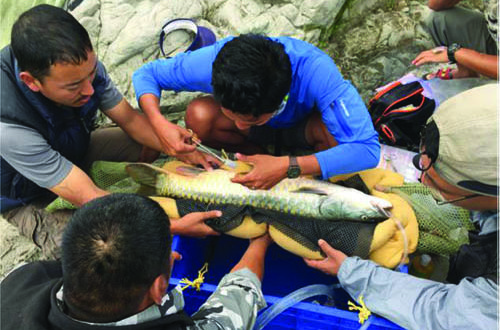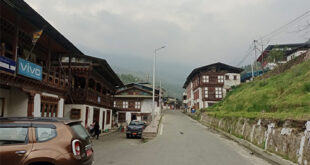100 golden and chocolate Mahaseers, both of which are freshwater fishes of the Himalayan rivers, have been successfully implanted with radio transmitters, which will help conservationists understand its migration, habitat and baseline population.
The transmitters are coded radio tags programmed to emit a coded signal every three seconds and lasts up to three years. The transmitters are surgically implanted into the body cavity of each fish.
Lack of information about the endangered fishes has hampered understanding of how to conserve the fish, which has undergone severe population declines as a result of over-exploitation, pollution and habitat loss according to Karma Wangchuk, a member of the Mahaseer Conservation team in Bhutan.
With such technology in place the information collected will be used for understanding fish biology and help develop strategies for better conservation and habitat assessment and also safeguard the endangered fish.
The radio transmitters provide live feeds of fish activities and behavior. The research project is focused on using radio telemetry in the two major arms of the Manas River, the Mangde Chhu and Dangme Chhu, to assess the Mahaseer spawning migrations.
The Mahaseer conservation team also intends to discern where the fish go during the monsoon and study whether or not they swim across the southern border into India.
The overall goal is to help generate information describing the Mahaseer life history in an effort to determine effective conservation strategies and management plans.
The data is retrieved from the stations placed along the river on a weekly basis and sent to the department of Livestock (DoL) in Thimphu where scientists based in USA receive the final data for analysis.
WWF Bhutan and Fishery Conservation Foundation, Department of Livestock installed the stations along the river.
The three-year long project worth Nu 7.5 million is funded by Michal Phillips, Fishery Conservation Foundation, USA, and WWF Bhutan.
DoL is taking the lead in undertaking the study in collaboration with WWF Bhutan and FCF USA with field collaboration and support from the department of forest and park services.
Receiver stations are also installed upstream in Dangme Chhu, confluence of the Sheri Chhu, Kuri Chhu , Mangde Chu river.
The Mahaseer is considered to be the least studied and currently considered “threatened” species of fish in the Himalayan region due to over human exploitation.
The Mahaseer research expedition to Bhutan was started in 2015
Five species are listed as “Endangered” and two as “Near Threatened” in the International Union for Conservation of Nature Red List of Threatened Species.
 The Bhutanese Leading the way.
The Bhutanese Leading the way.




